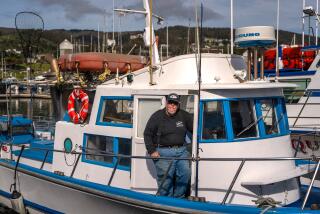Midway Battles Now Being Waged With Big-Game Fish
- Share via
Fifty-five years ago, Midway Island was the site of one of the fiercest and most decisive battles of World War II.
The tiny volcanic atoll in the middle of the Pacific was bombarded by the Japanese early on the morning of June 4, 1942, during an ill-fated attempt to occupy the two small islands--Sand and Eastern--that make up the atoll.
That led to the infamous Battle of Midway, during which the Japanese, caught off-guard by the United States, lost four aircraft carriers, 253 planes and 3,500 lives, and never regained the offensive. The United States lost one carrier, 150 planes and 307 lives.
Having long lost its importance from a military standpoint, Midway began a new chapter late last August when it began letting tourists ashore for the first time since before the war.
This was exciting news for adventurous fishermen, who looked forward to dropping their hooks into waters teeming with game fish whose populations were never pressured by commercial fishermen, fish that had no reason to be wary because they had never felt the sting of an angler’s hook.
Everyone expected big things from what basically was a virgin fishery. Big blue marlin. Big tuna. Incredibly big reef fish. “World records are sure to fall here,” promoters boasted.
Well, it is a year after Midway opened in late August 1996. The small fleet has spent its first full summer in operation. And the skippers, though they have only begun to tap Midway’s sprawling circular lagoon and the ocean beyond it, can sum up their assessment of Midway in a word: Big.
“I just got back [home to Kailua-Kona, Hawaii] after 10 days of the hottest fishing I’ve seen there yet,” said Rick Gaffney, world-renowned skipper who helped pioneer sportfishing at Midway. The catch included blue, black and striped marlin and sailfish in profusion. “We tagged and released 11 blue marlin estimated to weigh between 140 and 750 pounds. The stripey was small, and the black was estimated at 200 pounds, [but] it was the first of both species since Midway Sportfishing opened.”
Another first was the catch of bluefin tuna. Gaffney, with two anglers from Texas, caught three bluefin while night-fishing, the largest 191 pounds.
“The catch included many, many yellowfin tuna averaging about 70 pounds,” Gaffney said. “We try to avoid them while marlin fishing, but they attack our biggest marlin lures. [We caught] mahi-mahi to 40 pounds, many wahoo and, of course, scads of giant trevally.”
The giant trevally, or ulua, are powerful reef fish that patrol the lagoon like gangs of thugs. So plentiful and voracious are the oval-shaped game fish that an angler usually has one on the hook within minutes of leaving the docks.
So big are Midway’s giant trevally compared to those anywhere else that anglers from the United States and Japan--Midway is halfway between the mainland and Japan, hence the name--are converging on the atoll in hopes of setting a world record.
“The Japanese revere the giant trevally,” Gaffney said.
Thus far, six world records have been set, all of them line-class or fly-rod records, with the largest fish being a 105-pound trevally caught on 30-pound monofilament. (The all-tackle record is a 145-pound 8-ounce fish caught off Maui in 1991.)
Much larger fish have been hooked and more records would have been set, but in today’s Battle of Midway, the giant trevally have a decisive edge because of the jagged, cavernous world in which they live.
“Fishing inshore like that is like fishing over razor blades,” said Nick Curcione, a famous fly-fisherman from Redondo Beach. “I’m embarrassed to say this, but it’s the truth: I did not land a fish there [in 31 hookups, according to Gaffney] outside of a 200-pound shark. I donated many fly lines in that lagoon.”
Offshore, Midway anglers got off to a flying start last summer, with a 750-pound marlin being brought to leader on the first trip, leaving many to believe that Midway’s first “grander” would not be far behind.
But after about six weeks in operation, the weather began to change. It no longer felt like Hawaii. (Midway is the second northernmost of the Hawaiian chain, roughly 1,200 miles northwest of Honolulu.) Cold winds began to rage over the atoll, often for weeks at a time. Water temperatures dipped into the 60s.
Midway’s skippers soon realized that the offshore fishery, unlike that of Hawaii proper, would for the most part be seasonal.
Midway has yet to produce a 1,000-pound marlin, but Gaffney believes it is only a matter of time before one is landed.
“One fish estimated at 1,000 pounds has been seen, apparently in courtship with several lit-up males,” he said, “and several fish at about 750 pounds have been released.
“All the requirements of a 1,000-pound marlin are there, acres of tuna to feed on, etc., so it is just a matter of time. . . . It will happen, if not before the warm water goes away in late October, then next spring, summer or fall for sure, now that the fishing grounds are well established, the crews understand the waters and the anglers are coming consistently.”
ADD MIDWAY
Midway’s first tourists had to share the island--and the mess hall--with the Navy, which only recently shipped out entirely, giving way to U.S. Fishing and Wildlife Service personnel in charge of Midway Atoll National Wildlife Refuge.
“The island has a decidedly less military feel and look, but the history is still there,” Gaffney said. “Mess hall hours are now more tourist-like. Breakfast and dinner are better extended to accommodate fishermen and divers. The new French restaurant, the Ironwood, is open and is a fabulous respite from the hearty chow-hall fare.”
Guests still sleep in converted barracks and evidence of the infamous battle--from bombed-out buildings on Sand Island to the rusted anti-aircraft gun aimed skyward on the barren shore of Eastern Island--will forever serve as a reminder of those fateful days during World War II.
The wreck of the U.S. carrier Yorktown was recently pinpointed about 100 miles north of Midway, Gaffney said, adding, “the wreck may be shallow enough to access with scuba gear but the Navy cautions it had armed ordnance on deck when it sank and is highly volatile.”
“We hope it may also hold fish,” Gaffney said.
Those considering a fishing or diving trip to Midway can obtain further information by calling (770) 254-8326 or (888) 244-8582. Midway Sportfishing can also be reached on the Internet at www.midwaysf.com.
SHORT CASTS
The first Knabe Katch youth fishing celebration will be held Saturday at La Mirada Park Lake from 7-11 a.m. The event-- featuring a catfish derby and clinics--is free for 5- to 15-year-olds accompanied by an adult. Details: (626) 333-1369.
This is the show season. The annual Lido Yacht Expo will run next Thursday-Sunday at Lido Marina Village in Newport Beach. The annual Long Beach Boat Show will run Oct. 22-26 at the Long Beach Convention Center.
California Kayak Friends is holding a kayak-fishing derby Sept. 20 at 10 a.m. at Leo Carrillo State Beach. Details: (818) 349-8373.
The Department of Fish and Game predicts it will sell all 15,000 bear-hunting tags before the general seasons open later this month and advises those interested in hunting bear this year to act quickly if they hope to get in on the action. Applications are available at sporting goods stores, DFG offices and on the Internet at
www.dfg.ca.gov/lrb/huntbook.html.
As of Monday, 13,700 tags had been issued. Deer season openers in most zones are imminent as well, and quotas are expected to fill earlier than in the past, so the DFG urges those who haven’t already done so to send in the their applications for the respective zones in which they want to hunt. Details: (916) 227-2269, or at www.dfg.ca.gov.
More to Read
Sign up for The Wild
We’ll help you find the best places to hike, bike and run, as well as the perfect silent spots for meditation and yoga.
You may occasionally receive promotional content from the Los Angeles Times.






